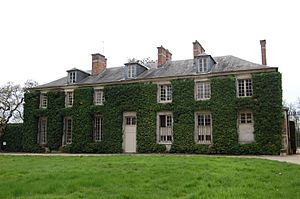Bernard de Jussieu facts for kids
Quick facts for kids
Bernard de Jussieu
|
|
|---|---|

Bernard de Jussieu
|
|
| Born | 17 August 1699 |
| Died | 6 November 1777 (aged 78) |
| Nationality | French |
| Scientific career | |
| Fields | Natural History |
Bernard de Jussieu (born August 17, 1699 – died November 6, 1777) was a French naturalist. He was the younger brother of another famous scientist, Antoine de Jussieu. Bernard de Jussieu is best known for his work with plants and for creating a new way to group them.
Contents
Who Was Bernard de Jussieu?
Bernard de Jussieu was born in the city of Lyon, France. He came from a family of well-known scientists. His older brother, Antoine, was also a naturalist. Bernard studied medicine at Montpellier University.
Starting His Career
After finishing his medical degree, Bernard started working as a doctor in 1720. However, he soon realized he didn't enjoy this work. In 1722, his brother Antoine invited him to Paris. Bernard happily accepted and took over a job at the Jardin des Plantes. This was a famous garden where plants were studied. He became a sub-demonstrator of plants, helping to teach others about them.
Important Early Work
In 1725, Bernard de Jussieu helped publish a new version of a book about plants. The book was called Histoire des plantes qui naissent aux environs de Paris. It was originally written by Joseph Pitton de Tournefort. Bernard's new edition was much more complete. Later, it was even translated into English.
In the same year, he joined the French Academy of Sciences. This was a very important group of scientists. He shared many of his discoveries and ideas with them.
Discoveries About Sea Creatures
Bernard de Jussieu was also interested in sea creatures. Long before other scientists, he believed that certain organisms found in water were actually animals. At the time, many people thought these creatures were just flowers of sea plants. To prove his idea, he traveled to the coast of Normandy three times. He studied these organisms closely and showed they were indeed animals.
His Plant Classification System
Bernard de Jussieu was a very modest person. He didn't publish many of his discoveries himself. But in 1759, he created a special way to organize plants. He used this system to arrange the plants in the royal garden of the Grand Trianon. This garden is located at the famous Palace of Versailles.
His classification system was very important. It was later used by his nephew, Antoine Laurent de Jussieu, in his own major book called Genera plantarum. Bernard cared more about sharing new facts than getting credit for them. When his brother Antoine passed away, Bernard refused to take his place as a professor of botany. Instead, he convinced another scientist, L. G. Lemonnier, to take the important job.
Recognition and Legacy
Bernard de Jussieu was recognized for his scientific contributions. In 1749, he was chosen as a foreign member of the Royal Swedish Academy of Sciences.
Today, when scientists talk about plants that Bernard de Jussieu described, they use the short name B.Juss. This is a special way to give him credit for his work.


